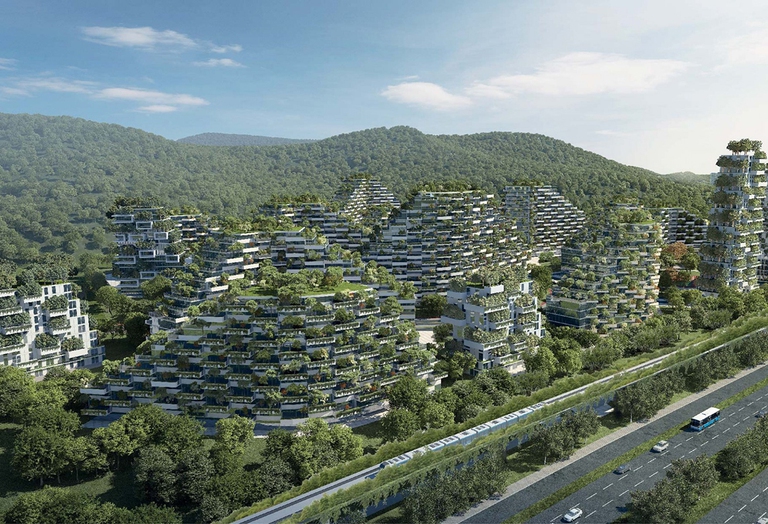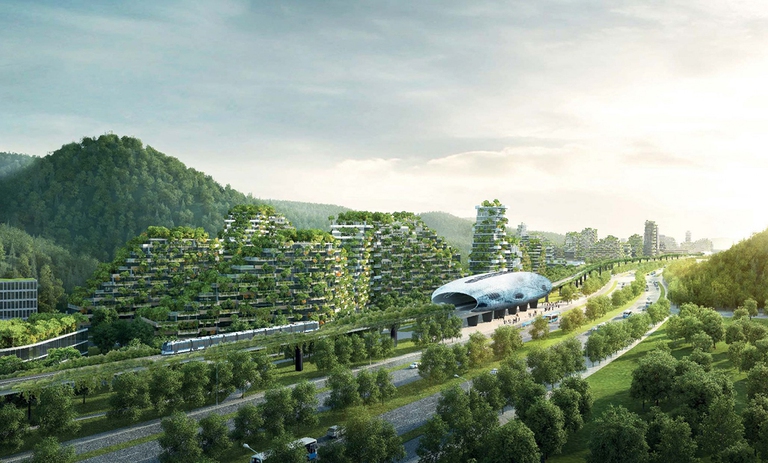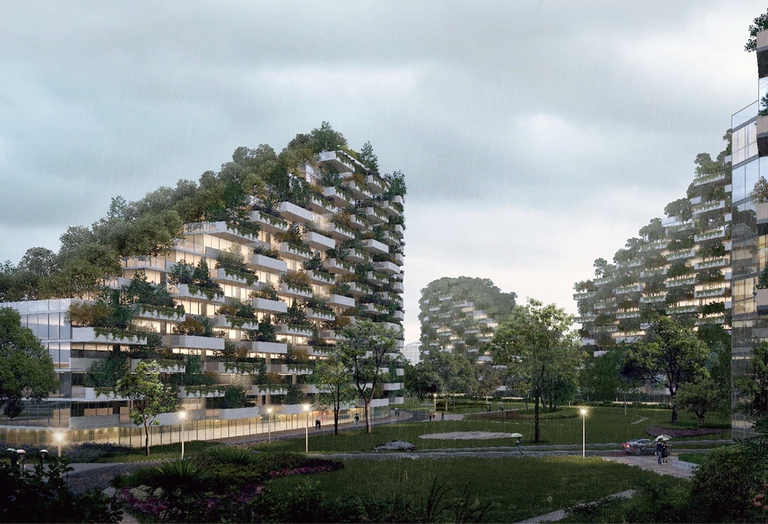
The Amazon became an alternative classroom during the pandemic. Now, the educational forest in Batraja, Bolivia, lives on to teach children and adults the value of nature.
A million plants and 40,000 trees. Liuzhou Forest City, designed by architect Stefano Boeri, is set to be inaugurated in 2020 in the northern Chinese city.
After the success of Milan’s Vertical Forest, or Bosco Verticale in the original Italian, which was chosen as the best building in the world by the Council on Tall Buildings and Urban Habitat (CTBUH) in 2015, the team at Stefano Boeri Architects continues in its creation of a new generation of urban settlements that are capable of facing the challenges of climate change, a new architectural model for the future of our planet. Liuzhou Forest City will rise in the north of the city located in the mountainous province of Guangxi, in northern China, in an area of about 175 hectares next to Liujiang Lake.
Read more: Urban forestry must become the core of city planning: the call by Stefano Boeri, the architect behind Vertical Forests
Boeri’s desire to create veritable forest cities – compact urban centres made up of dozens of buildings like the Vertical Forests found in Milan, Nanjing (China) and Utrecht (The Netherlands) surrounded by trees, shrubs and blooming plants – in China has finally become a reality. Liuzhou Forest City, commissioned by Liuzhou Municipality Urban Planning, authority dedicated to the Chinese city’s development, will be a cohesive unit of buildings, streets, trees and plants of every kind, and it will host more than 30,000 inhabitants who will be able to enjoy homes, schools, offices, hospitals and all kinds of services in an area completely covered in plant life, where trees aren’t just a decoration but an integral part of the structure. So much so, that it will be nearly impossible to distinguish the urban centre from the green area that surrounds it when observed from above.
https://www.youtube.com/watch?v=nHq9yQOb1eQ
Liuzhou Forest City will be the first zero impact, autonomous urban agglomeration. As underlined by Stefano Boeri Architects, the city will have all the characteristics of a fully self-sufficient settlement from an energy standpoint: geothermal energy will be used for temperature regulation inside the buildings and an integrated solar panel system will be installed on the roofs; the connections between the new centre and the city of Liuzhou will be guaranteed by an electric train railway.
All of this will provide many environmental benefits. The strong presence of vegetation will improve air quality by absorbing 57 tonnes of carbon dioxide and particulate matter, and producing 900 tonnes of oxygen every year, as well reducing average temperatures. This will be possible thanks to the planting of 40,000 trees and approximately one million plants of more than a hundred different species that will be placed in streets and buildings.
Read more: Urban forests, cities’ answer to climate change (and much more)
From Vertical Forests to Liuzhou Forest City, the themes advanced by Boeri and his team are those of urban forestry and the protection of biodiversity in large cities. Here are some of the fundamental aspects of his approach: avoiding the unrestrained use of cement, blocking the expansion of cities by enclosing them in forests, safeguarding forests and biodiversity within cities to reduce pollution and finally making nature an essential component of architecture.
“Cities produce nearly 70 per cent of carbon dioxide emissions, the cause behind phenomena such as the greenhouse effect, the melting of ice caps and sea level rise, whilst forests and oceans are the main enemies of CO2, absorbing approximately 35 per cent of the amount emitted – Boeri explains –. Bringing forests within cities, or creating forest cities means fighting the enemy on its turf, and transforming carbon dioxide into a fertiliser to feed plants”.
Liuzhou Forest City is another step forward for China, following the lead of the Nanjing Vertical Forest, the first one in Asia. The country is increasingly oriented towards eco-friendly policies with regards to housing and the use of renewable energy, reducing its reliance on coal.
“There are 14 million people who leave the rural areas in China every year and move to cities and the problem of air pollution is incredibly relevant – Boeri underlines –. The government has finally decided to answer this migration by considering the possibility of building smaller cities, and in this case one hundred per cent green ones, instead of constructing enormous suburban areas”.
An excellent starting point for a greener future oriented towards reducing pollution in China, the country with the highest rate of greenhouse gas emissions and particulate matter in the world. Therefore, Liuzhou Forest City (which should be inaugurated in 2020) will represent a totally “green” settlement as well as a new urban model for the future, where housing necessities and respect for the environment coexist in harmony.
Siamo anche su WhatsApp. Segui il canale ufficiale LifeGate per restare aggiornata, aggiornato sulle ultime notizie e sulle nostre attività.
![]()
Quest'opera è distribuita con Licenza Creative Commons Attribuzione - Non commerciale - Non opere derivate 4.0 Internazionale.
The Amazon became an alternative classroom during the pandemic. Now, the educational forest in Batraja, Bolivia, lives on to teach children and adults the value of nature.
Sharon Lavigne, one of the six winners of the 2021 Goldman Environmental Prize, is fighting to protect her community from plastics corporations.
Plastic pollution is airborne too. Microplastics are being carried across continents by the wind, as a recent study reveals.
Our species took its first steps in a world covered in trees. Today, forests offer us sustenance, shelter, and clean the air that we breathe.
Levels of particulates in New Delhi in 2020 were once again far above safety thresholds, with extremely serious health consequences for its citizens.
A major oil spill in the Ecuadorian Amazon in April has left the Coca River polluted. The indigenous Kichwa are suing the companies whose pipelines broke.
Molecules that eat up plastic waste, including PET bottles, may soon become widely used as scientists leap ahead in developing new super enzymes.
In Italy’s Land of Fires between Naples and Caserta, activists like Carmen Medaglia are fighting to promote new ways of managing waste.
Toxic substances in Kamchatka’s waters have killed 95% of marine fauna and caused health problems for surfers. The causes, however, are still unknown.











